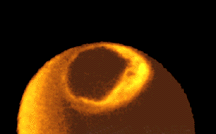Storm Front
Coronal mass ejections occur at a rate of a few times a week to several
times per day, depending on how active the Sun may be. And because of the
size of the plasma clouds they produce, the odds say Earth is going to get
hit by a CME from time to time. Fortunately, our planet is protected from
the harmful effects of the radiation and hot plasma by our atmosphere and
by an invisible magnetic shell known as the magnetosphere. Produced as a
result of Earth’s own magnetic field, the magnetosphere shields
us from
most of the Sun’s plasma by deflecting it into space.
But some energetic particles do enter the magnetosphere from time to time,
funneling in near the North and South Poles, where the magnetic field is
weakest and the magnetosphere is partially open to space. The rain of
plasma into our magnetosphere can induce magnetic storms, alter Earth’s
magnetic field as measured on the ground, and produce the phenomena known
as auroras.
Many things can happen in the magnetosphere during a magnetic storm
because a lot of energy is being dumped into the system. When impacted by
plasma from
Finally, some of the excited particles in the radiation belts can plunge
into the upper atmosphere, where they collide with oxygen and nitrogen.
These collisions—which usually occur between 40 and 200 miles above
ground—cause the oxygen and nitrogen to become electrically excited and to
emit light (fluorescent lights and televisions work in much the same way).
The result is a dazzling dance of green, blue, white, and red light in the
night sky, also known as aurora borealis and aurora australis (“northern
and southern lights”). Auroras can appear as colorful, wispy curtains of
light ruffling in the night sky, or sometimes as diffuse, flickering
bands. Either way, they tell us that something electric is happening in
the space around Earth.
|
/ NASA Home / Goddard Space Flight Center Home /
